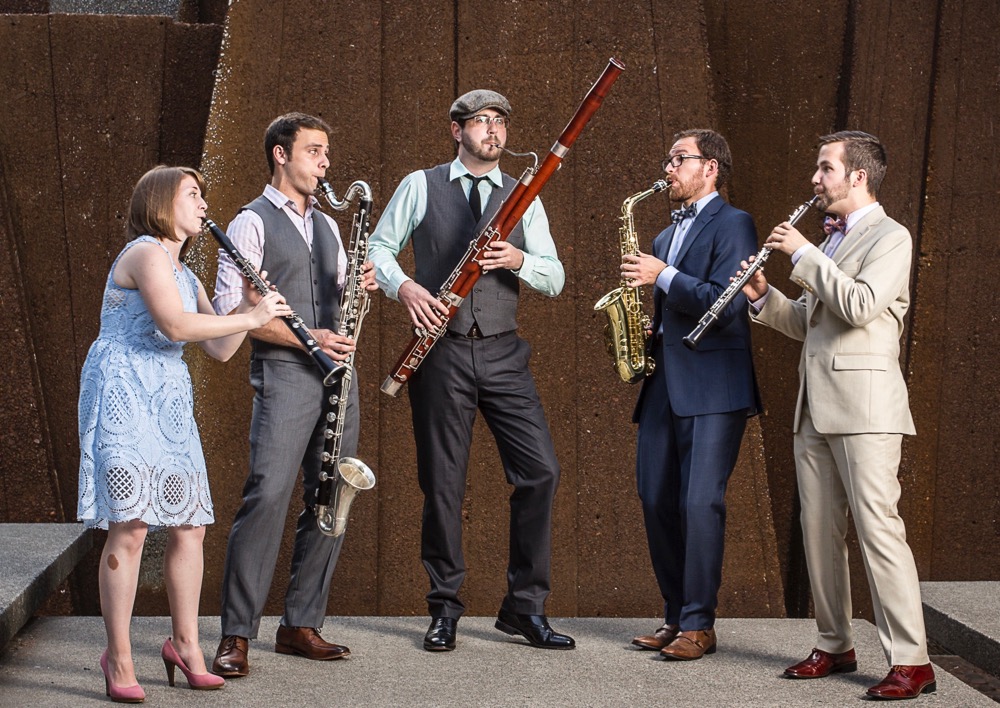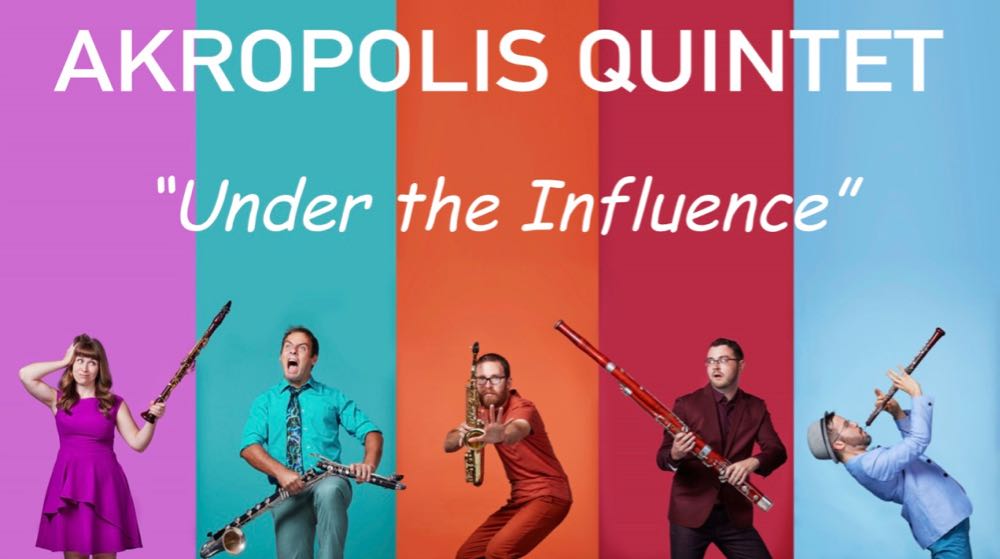
On Sunday, October 7 at 2:00 PM, Allegheny RiverStone Center for the Arts is proud to bring back to its Lincoln Hall audience the innovative, award winning ensemble, AKROPOLIS QUINTET, which in the spring of 2017 performed workshops and assembly concerts exclusively in ARCA’s Educational ArtReach residency program in the Allegheny-Clarion Valley Schools.
In “Under the Influence,” Akropolis presents classical music bearing a wide array of influences, from rock and electronic music to jazz, tango, and folk songs. Including works by Gershwin, Piazzolla, and living legends Marc Mellits, Nico Muhly, and Rob Deemer, each work absorbs the characteristics of a different genre, style, or era, and then creates fresh, relevant music, reflecting upon the original and looking forward. Akropolis also explores their own influences as a reed quintet as they build their ensemble’s repertoire and re-visit their personal and collective inspirations by which they have forged their genre-bending identity.
Hailed as “pure gold” by the San Francisco Chronicle, Akropolis Reed Quintet performs with infectious energy and spectacular color. Winners of the Fischoff Gold Medal in 2014 and the 2015 Fischoff Educator Award, the Quintet has embarked on an ambitious performance season touring their inventive concerts and workshops across America. Fresh off the release of their third commercial album, The Space Between Us (Innova Records) Akropolis has just launched a colorful and interactive new website!
Exploding with intensity and hailed for their “imagination, infallible musicality, and huge vitality” (Fanfare Magazine), the Akropolis Reed Quintet takes listeners on extraordinary musical adventures. Founded in 2009, Akropolis has won seven national chamber music prizes since 2011, including the 2014 Fischoff Gold Medal. Deeply committed to nurturing music appreciation among young audiences, Akropolis is also winner of the 2015 Fischoff Educator Award.
Originating at the University of Michigan in Ann Arbor, Akropolis remains Tim Gocklin (oboe), Matt Landry (saxophone), Ryan Reynolds (bassoon), Andrew Koeppe (bass clarinet), and Kari Landry (clarinet). Akropolis delivers passionate, energized, and unforgettable performances on a variety of series both traditional and adventurous in nature. All Akropolis events include informative musical introductions and a chance to greet the artists.
Akropolis’ impressive list of recent and upcoming appearances include stops at Caramoor, Chamber Music Northwest, the Chautauqua Institution, Artist Series of Sarasota, Chamber Music Abu Dhabi, Chamber Music Columbus, and more. Akropolis has been awarded a juried showcase at APAP (YPCA), Chamber Music America twice, Performing Arts Exchange, Western Arts Alliance, and the Mid-Atlantic Performing Arts Market. With three studio albums, including its March, 2017 release of The Space Between Us, called “Pure gold” by the San Francisco Chronicle, Akropolis has recorded 17 original reed quintet works.
Residency in the Allegheny-Clarion Valley Schools in 2017
The 19th century Romantic composer, Robert Schumann, proclaimed that, “The artist’s vocation is to send light into the human heart”. And bright it was in the Allegheny-Clarion River Valley on Tuesday, February 21, 2017 as the dazzling artistry of The Akropolis Reed Quintet flooded joyous and glorious music making and inspired instruction to more than 700 students from grades K – 12 in the Allegheny-Clarion Valley School system.
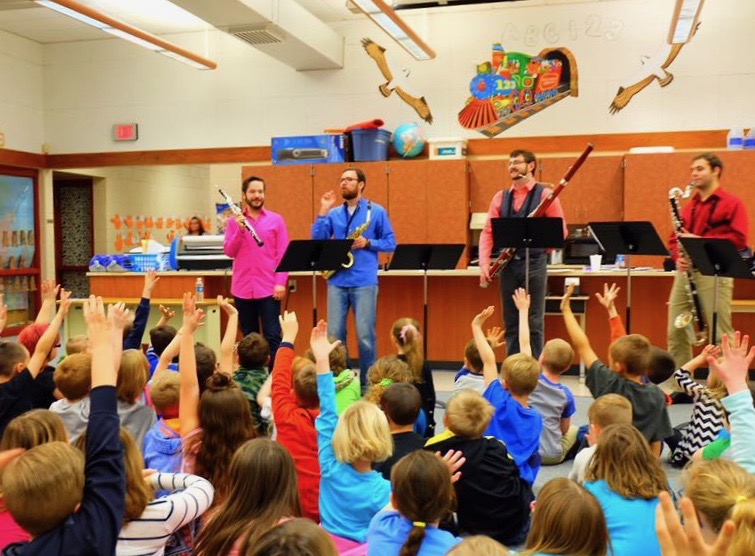
Beginning with three small “pod” classroom performances in the informal community spaces outside of Grades 1 – 6 classrooms, the award winning Arkopolis Reeds Teaching Artists introduced students to their instruments and engaged the students in telling a story with music that expresses emotions – with a student volunteer depicting it visually on a white board. The Reeds said that the A-C Valley students were the best-prepared group with which they had worked. Thanks to the advance preparation given to students by A-C Valley music specialist and choral director, Jennifer Powell Lowrey, when asked what one of the lesser known instruments was, a first grader answered, Oboe – and spelled it correctly!
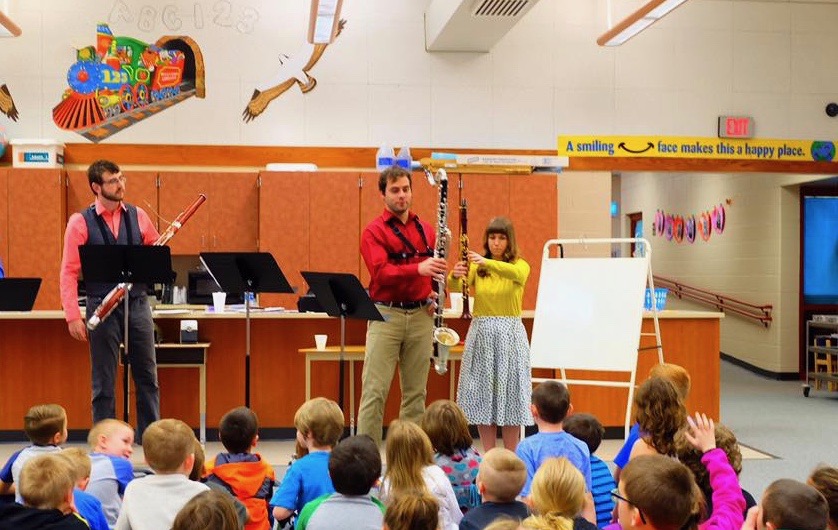
In the afternoon, a full gymnasium of students from K – 6 were in rapt attention as the artists remarkably extended classroom dynamics and student interaction to track melodies as performed by members of the ensemble. The elementary assembly concert culminated in the musical and narrated dramatic presentation of “The Best Story” with musicians playing multiple roles from sharks to pirates, replete with costumes.
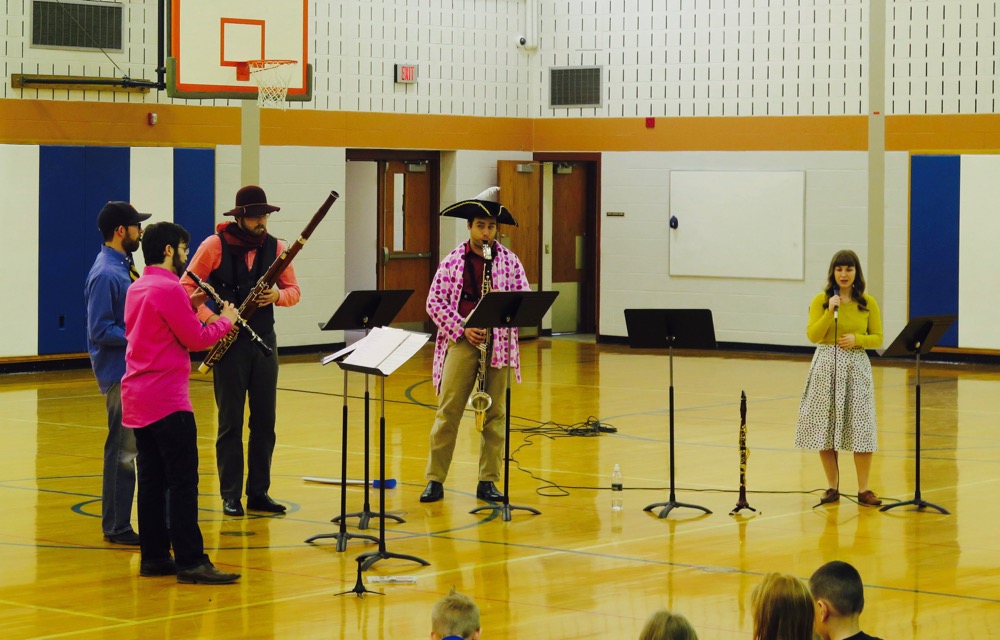
Later in the afternoon the Akropolis Reeds moved up to the High School to perform a more “hip” assembly concert for grades 7 – 12, including a brilliant arrangement of George Gershwin’s orchestral work, American in Paris, and Q/A about issues relevant to them.
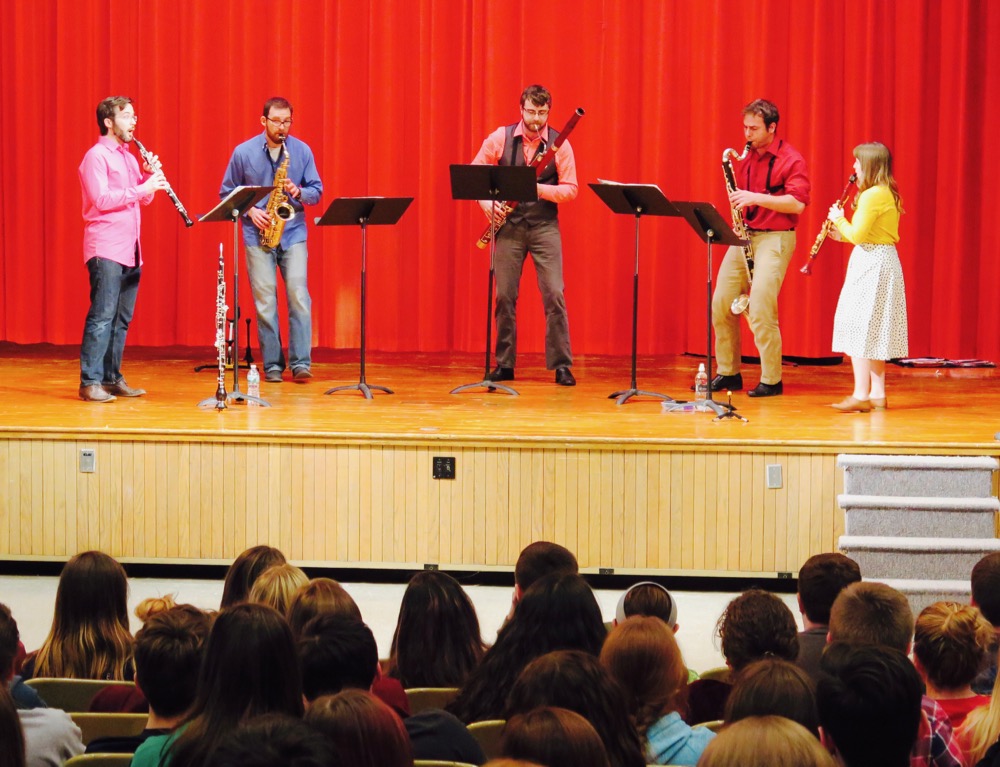
The day concluded with after-school hands-on technical workshops and master classes with A-C Valley students. A-C Valley Jr/Sr High Band Director, Scott DiTullio, and Elementary band teacher, Karen Hetrick, had prepared five small ensemble groups from grades 5 – 12 including flute, saxophones and clarinets, which performed for the Akropolis Reeds.
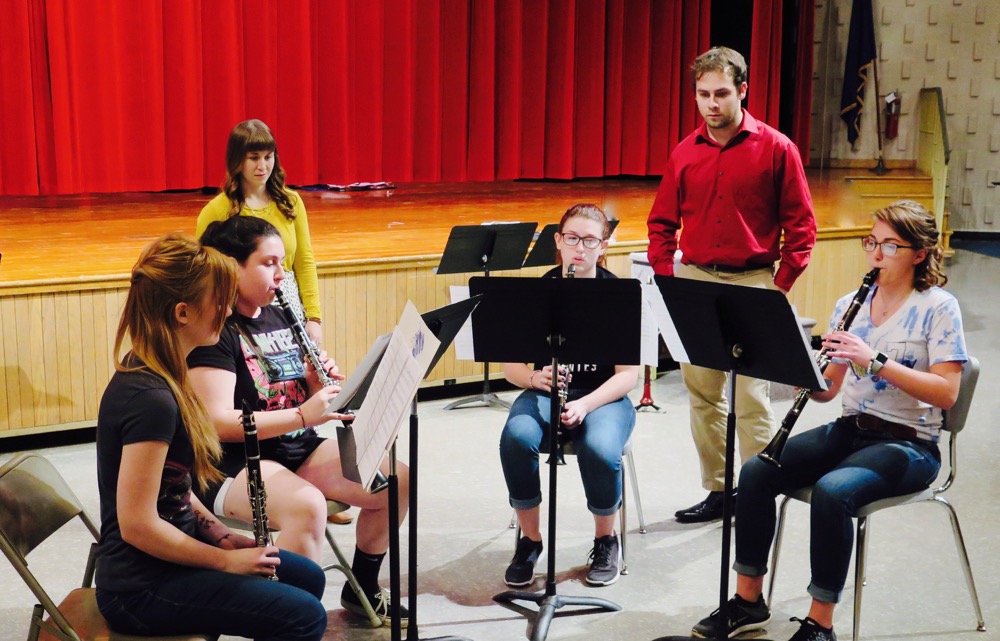
The Akropolis Reeds are the very pinnacle of Teaching artist ensembles in America today. A music educator wrote after a recent residency, “Akropolis performed for our middle school and did a wonderful job of entertaining as well as educating. Concepts of musical structure and imagery were brought to the students’ attention with wit, depth, and accessibility. My only complaint is that they couldn’t stay for a month!” After their residency in A-C Valley Schools, teachers and students alike felt the same way!
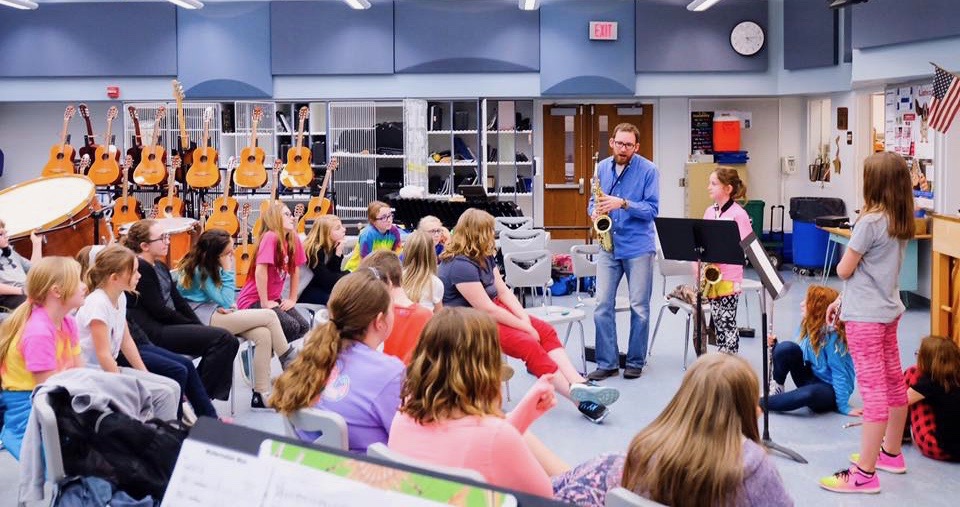
This residency was made possible by ARCA’s partnership with the A-C Valley Schools, a grant from the Pennsylvania Council on the Arts and contributions from ARCA Members and Donors.
“Under the Influence”
PROGRAM: Under the Influence
In “Under the Influence,” Akropolis presents classical music bearing a wide array of influences, from rock and electronic music to jazz, tango, and folk songs. Including works by Gershwin, Piazzolla, and living legends Marc Mellits, Nico Muhly, and Rob Deemer, each work absorbs the characteristics of a different genre, style, or era, and then creates fresh, relevant music, reflecting upon the original and looking forward. Akropolis also explores their own influences as a reed quintet as they build their ensemble’s repertoire and re-visit their personal and collective inspirations by which they have forged their genre-bending identity.
Splinter
Composer Marc Mellits’ music contains driving rhythms, soaring lyricism, and colorful orchestrations, which might seem difficult to capture all at once. In the case of his first work for reed quintet–formed in short miniatures like most of Mellits’ music–the listener experiences repetitious motives which, through subtle changes, create elongated phrases and broader musical structures. Even among the identical openings of movements 1 and 6 (as well as a few bars of directly transplanted content in movements 5 and 8), the listener gets a broader sense of the greater architecture in the work, even as motives continue to drive, repeat, and subtlety evolve. Mellits’ musical upbringing was varied, including rock and electronic music influences, which became a part of his musical instincts early on and make a thrilling contribution to his classical compositions today.
Look for Me
Nico Muhly’s Look for Me buries the melody of “Mother in the Graveyard,” a folk song created in the Vermont Appalachia, inside destabilizing, modernized textures and interjections. The resulting sound is as if we are hearing an original field recording, but the wax has been distorted, and we are listening to the original singer as he or she jumps through and is warped by the time travel to today. Through the well-planted organization of these textures and interjections, Muhly re-establishes the beauty of the original, simple field song in a modern context. The composer of the folk song, “Mother in the Graveyard,” is Margaret MacArthur, a renowned performer and archivist of American folk melodies. Originally a city-goer, she and her husband moved to a 200 year-old farmhouse in Marlboro, VT in 1951, where she preserved instruments and field recordings, living without electricity or running water for the first 6 years in the home. Here are two verses of “Mother in the Graveyard”:
Mother in the graveyard and I’m on the land
Look for me
Mother in the graveyard and I’m on the land
And I want God’s bosom to be my pillow
Hide me over in the rocks of ages
Look for me
Drive the chariot to my door
Look for me
Drive the chariot to my door
And I want God’s bosom to be my pillow
Hide me over in the rocks of ages
Look for me
Libertango
Closing the first set is Astor Piazzolla’s famous Libertango, first released in 1974. “Liber,” meaning “liberty,” was one of Piazzolla’s compositions in the “tango nuevo” form he would continue exploring for the rest of his career. Piazzolla’s tangos have become popular with classical musicians because Piazzolla was classically trained and his compositions often contain intricate counterpoint. Nuevo tango includes elements of jazz, modern classical dissonance, and a variety of instrumentations for which Piazzolla composed. This makes his music malleable, and Akropolis is delighted to have discovered this arrangement of Libertangowhile conducting a master class at Northwestern University in February, 2018.
Gallimaufry
In Gallimaufry, Deemer uses each instrument as a different, unique material, considering its sound, volume envelope, and articulations. He combines them to allow the listener to hear both each instruments’ singular colors as well as the reed quintet’s combined palette. When conceiving this work and beginning to compose it, Deemer announced to Akropolis his vision of the piece and of the reed quintet as an object: a giant Dr. Seuss-inspired instrument that could break apart into smaller pieces, morph and evolve, then return to its original form. “Gallimaufry” is a word which means “hodge-podge” or a gumbo or stew.
An American in Paris In conclusion, Akropolis presents a work inspired not only by the popular music of the early 20th century, but marked by a special moment in music composition in which the concept of “acceptable” art music was beginning to rapidly evolve. In An American in Paris, Gershwin aimed to create one of his more serious works despite his natural affinity for frivolity. He consulted Ravel about this conundrum, who wisely instructed that if Gershwin was making more money than Ravel (which he was), he shouldn’t change how he writes his music. He sought advice from Nadia Boulanger, the great teacher of Aaron Copland and others. She also wisely suggested to Gershwin try to be no one but Gershwin. And so, using complex motivic development which is constantly modulating and changing form, Gershwin manages to create his most accessible, but simultaneously most complex piece of music. Among the challenges Dutch saxophonist Raaf Hekkema faced in arranging the work were how to convey these ideas with only 5 instruments. The listener might find Gershwin’s ideas even easier to deduce in the chamber music format, and Hekkema brilliantly manages to maintain Gershwin’s lush orchestrations by having all 5 members performing for nearly all of the arrangement. The continually repeating and evolving motives make for a challenging but thrilling performance which Akropolis is delighted to bring to the stage.
CONCERT PROGRAM
Marc Mellits (1966)
Splinter (2014)
- Scarlet Oak
- Sugar Maple
- Linden
- Black Ash
- Cherry
- River Birch
- Weeping Willow
- Red Pine
Nico Muhly (1981)
Look for Me (2015)
Astor Piazzolla (1921-1992)
Libertango (1974) arr. Christopher Rueda
Intermission
Rob Deemer (1970)
Gallimaufry (2015)
George Gershwin (1898-1937)
An American in Paris (1928) arr. Raaf Hekkema
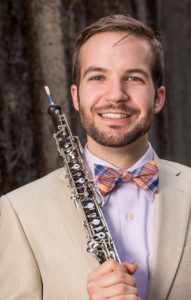 Known for his sensitive, colorful and engaging performances, Timothy Gocklin shares his passion for music through his deep love for the oboe. Tim’s relationship with the oboe began at age 11, the day after attending a military band concert featuring the oboe. Since then, he has gone on to perform with some of the world’s leading artists, including Yo-Yo Ma and Richard Stolzman.
Known for his sensitive, colorful and engaging performances, Timothy Gocklin shares his passion for music through his deep love for the oboe. Tim’s relationship with the oboe began at age 11, the day after attending a military band concert featuring the oboe. Since then, he has gone on to perform with some of the world’s leading artists, including Yo-Yo Ma and Richard Stolzman.
Outside of Akropolis, Tim performs chamber music in a wide variety of settings. He performed Hindemith’s Die Serenaden as part of the Yale in New York series at Carnegie’s Weill Recital Hall, and he has participated in the Sarasota and Norfolk Chamber Music Festivals. As a fellow of the Norfolk Chamber Music Festival, Tim had the privilege of working with Carol Wincenc and William Purvis in a performance of Charles Gounod’s Petite Symphonie and Emile Bernard’s Divertissement. In addition, Tim spent the summer of 2012 as a member of the Interlochen Ensemble, a quintet-in-residence at the Interlochen Arts Camp performing around the state of Michigan.
In addition to Tim’s active career as a chamber musician, he has also been fortunate to have opportunities performing as a soloist. In 2009, Tim was announced winner of the inaugural U.S. President’s Own “Marine Band” Concerto Competition, and as a result performed Haydn’s Oboe Concerto with the ensemble at the MTNA national conference in Milwaukee, WI. A few months earlier Tim was invited to perform Bach’s Concerto for Violin and Oboe in C minor as a guest soloist with the Nashua Chamber Orchestra.
Tim can be heard on the NAXOS and Block M record labels and has participated in other recording projects, including two albums with the University of Michigan Symphony Band in 2010 and 2012, the second of which featured new works for wind ensemble under the direction of Michael Haithcock. These works were taken on a tour to China where the band performed 9 concerts in 6 cities, including at Beijing’s National Centre for the Arts and Shanghai’s Grand Theatre. In 2011, he recorded the three piano concerti of Alberto Ginastera with pianist Barbara Nissman and the University of Michigan Symphony Orchestra.
In 2012, Tim received his Bachelors degree summa cum laude from the University of Michigan where he studied with Dr. Nancy Ambrose King. He went on to complete his Master of Music degree at Yale University studying with Steven Taylor. When not playing the oboe or widdling away at his reeds, Tim can be found relaxing in a coffee shop with a journal and pencil on one side and a hot, robust cup of coffee on the other.
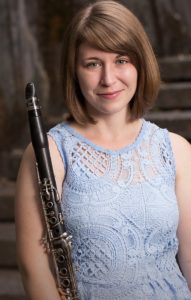 Kari Landry is a Backun Artist and the clarinetist of the acclaimed Akropolis Reed Quintet. Founded in 2009 at the University of Michigan and hailed by Fanfare Magazine as performing with “imagination, infallible musicality and huge vitality”, the Akropolis Reed Quintet delivers over 70 engaging performances and educational outreach events every year for communities around the United States and abroad.
Kari Landry is a Backun Artist and the clarinetist of the acclaimed Akropolis Reed Quintet. Founded in 2009 at the University of Michigan and hailed by Fanfare Magazine as performing with “imagination, infallible musicality and huge vitality”, the Akropolis Reed Quintet delivers over 70 engaging performances and educational outreach events every year for communities around the United States and abroad.
As the Marketing and Development Manager of Akropolis’ 501(c)(3) nonprofit, Kari is committed to increasing access to classical music within communities and educating the next generation of musicians to ensure that a vibrant culture of art persists in our society.
Kari is currently the Marketing & Programs Manager at the Ann Arbor Summer Festival, an exhilarating celebration of performing arts, outdoor entertainment, and community spirit. Offering 170 + concerts and events to discover with 80,000+ attendees annually, A2SF showcases the best in music, dance, comedy, film, circus and street arts, and family entertainment. Going on her third season with the festival, Kari’s responsibilities range from digital media & web management, digital & print marketing, program booking, graphic content creation, and nightly event management.
Prior to her current position, Kari received a Michigan EMMY for best historical documentary for her work on “A Space for Music, A Seat for Everyone” showcasing 100 Years of University Musical Society Performances in Hill Auditorium.
Kari received her bachelor’s and master’s degrees in clarinet performance from the University of Michigan, studying with Cleveland Orchestra clarinetist Dan Gilbert. Kari was the Eb Clarinetist in the University of Michigan Symphony Band’s 2011 tour to China, which released a recording of premiere band works by the composers Kristin Kuster, Bright Sheng and Michael Daugherty under the Block M record label. Kari has also spent two of her college summers at the Aspen Music Festival. As an avid clarinet teacher in southeast Michigan, Kari owes all of her musical success to her instructors. Her clarinet teachers have included Dan Gilbert, Chad Burrow, Ted Oien and Suzy Dennis-Bratton.
 Matt Landry began his music career gigging and teaching as a pianist. He took up the clarinet after piano, and finally the saxophone in middle school. Born in New Orleans before moving to Michigan, Matt dabbles in and appreciates many musical styles. One winter upon reading The Devil’s Horn, a book about the saxophone’s invention and inventor, Matt fell in love, finding the instrument he would stick with for good.
Matt Landry began his music career gigging and teaching as a pianist. He took up the clarinet after piano, and finally the saxophone in middle school. Born in New Orleans before moving to Michigan, Matt dabbles in and appreciates many musical styles. One winter upon reading The Devil’s Horn, a book about the saxophone’s invention and inventor, Matt fell in love, finding the instrument he would stick with for good.
Matt has performed on several concerts with Orchestra Canton, including Milhaud’s La Création du Monde, and he has performed Bernstein’s On the Town with the Dearborn Symphony. He also appears regularly with the Michigan Philharmonic. As well as Akropolis’ two studio albums, he can be heard on two CDs produced by the UM Symphony Band under the Equilibrium Records label, Raise the Roof and Classic Structures. Matt received his Bachelors degree Summa Cum Laude in Music Education and Saxophone from the University of Michigan, where he studied with Donald Sinta.
Matt is an avid educator and community engagement specialist. He was a full-time piano teacher at the Expressions Music Academy in Novi, MI where he was also Director of Marketing and Outreach, connecting Expressions to neighborhood businesses, schools, and families. Presently he works for the Detroit Regional Chamber as an outreach specialist to small businesses in Detroit and the Detroit metro area.
Matt has also taught middle school band and elementary music full time and he has helped create after-school music programs in west Detroit. Matt also interned at the Detroit Symphony Orchestra in Neighborhood Audience Development.
In his spare time he enjoys writing, reading, collecting more pianos than his small home has room for, running even though his knees won’t allow it, and trying to emulate the southern cooking styles of his extended southern family.
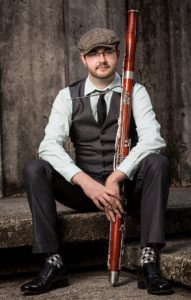 Ryan Reynolds chose the bassoon in 5th grade under the impression that it produced only one note and would therefore be the easiest instrument to play. His disappointment upon discovering three and a half octaves of notes quickly turned to fascination and intrigue, with the “gorgonzola of the orchestra” providing daily mysteries and rewards.
Ryan Reynolds chose the bassoon in 5th grade under the impression that it produced only one note and would therefore be the easiest instrument to play. His disappointment upon discovering three and a half octaves of notes quickly turned to fascination and intrigue, with the “gorgonzola of the orchestra” providing daily mysteries and rewards.
Ryan is currently the Graduate Teaching Assistant for the Florida State University bassoon studio, and has performed with the Traverse and Ann Arbor Symphony Orchestras. In 2009, Ryan toured the upper peninsula of Michigan with the Sonrisa Wind Quintet as an artist-in-residence for the Pine Mountain Music Festival, and in 2012 was a member of the Interlochen Ensemble, a wind quintet built entirely of Interlochen alumni that toured around the Midwest.
A passionate educator, Ryan has taught a studio of young bassoonists from throughout southern Michigan, and is currently teaching many of the undergraduate bassoon students at Florida State University. Ryan has taught numerous beginning bassoon camps, masterclasses, and clinics at schools around the United States. He has taught bassoon methods classes at the collegiate level, and coaches several chamber ensembles at FSU.
Ryan has been featured on National Public Radio’s “From the Top”, Interlochen Public Radio, and can be seen in numerous videos in the University of Michigan Bassoon Studio YouTube series.
After attending the Interlochen Arts Academy from 2004-08 where he studied with Dr. Eric Stomberg, Ryan replaced his ‘Interlochen blues’ with Michigan’s, attending the University of Michigan from 2008-2014 while studying with Dr. Jeffrey Lyman. Ryan is currently pursuing his DMA degree at Florida State University under the tutelage of Jeff Keesecker. Ryan is adamant that his sports allegiances still lie with the Maize and Blue.
Ryan’s ultimate goal is to become a respected pedagogue at the university level, and he is grateful to have studied with a series of devoted and inspiring teachers.
 An Ann Arbor native, Andrew Koeppe majored in clarinet at the University of Michigan and studied with Chad Burrow, Deborah Chodacki and Monica Kaenzig. He performed in the University Symphony Band under the direction of Michael Haithcock, and the University Symphony Orchestra and University Opera Theater under the direction of Kenneth Kiesler. Andrew can be heard on two University of Michigan CDs, including interactions with acclaimed soloists Nancy Ambrose King and Adam Unsworth, as well as the premiere of William Bolcom’s Symphony for Band. He was the featured clarinet soloist in Bolcom’s band orchestration of “Graceful Ghost Rag” on the University of Michigan Symphony Band CD Artifacts. Today, he is a regular performer with the Ann Arbor Symphony Orchestra.
An Ann Arbor native, Andrew Koeppe majored in clarinet at the University of Michigan and studied with Chad Burrow, Deborah Chodacki and Monica Kaenzig. He performed in the University Symphony Band under the direction of Michael Haithcock, and the University Symphony Orchestra and University Opera Theater under the direction of Kenneth Kiesler. Andrew can be heard on two University of Michigan CDs, including interactions with acclaimed soloists Nancy Ambrose King and Adam Unsworth, as well as the premiere of William Bolcom’s Symphony for Band. He was the featured clarinet soloist in Bolcom’s band orchestration of “Graceful Ghost Rag” on the University of Michigan Symphony Band CD Artifacts. Today, he is a regular performer with the Ann Arbor Symphony Orchestra.
While studying at the University of Michigan, Andrew performed in clarinet master classes with Stanley Drucker (New York Philharmonic), Carey Bell (San Francisco Symphony), Julia Heinen (Professor, California State University), and Eighth Blackbird. He was also selected to attend the Buffet-Crampon USA Clarinet Academy in Jacksonville, Florida in 2009 where he studied with clarinetists Eugene Mondie, Dan Gilbert, Andre Moisan, and Ixi Chen.
Also in 2009, Andrew played principal clarinet and bass clarinet in a small orchestral ensemble of select University of Michigan students in a weeklong multi-media workshop and final performance of “Ask Your Mama” with composer Laura Carpman, curator Jessye Norman, and conductor George Manahan. This new work later premiered at Carnegie Hall.
Andrew has also performed with the Michigan Youth Orchestra, the University of Michigan All-State Orchestra at Interlochen, and in large and small ensembles at the Michigan Youth Arts Festival. He teaches clarinet and bass clarinet in Ann Arbor as well as at the Expressions Music Academy in Novi, and performs as a soloist in churches in the Ann Arbor area.
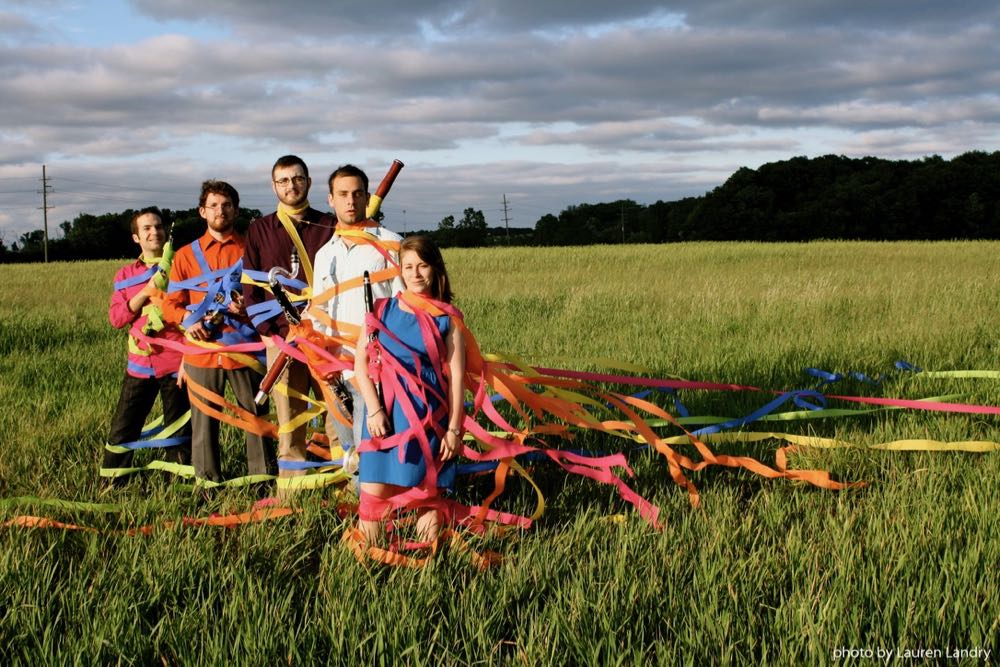
Hailed for their “imagination, infallible musicality, and huge vitality” (Fanfare Magazine), the Akropolis Reed Quintet takes listeners on extraordinary musical adventures. Founded in 2009 at the University of Michigan, Akropolis has won seven national chamber music prizes since 2011, including the 2014 Fischoff Gold Medal and the 2015 Fischoff Educator Award. Akropolis is an alumnus of APAP’s prestigious Young Performer’s Career Advancement Program and has received grants from the National Endowment for the Arts (Art Works), the Michigan Council for Arts and Cultural Affairs, CultureSource, Quicken Loans, and Chamber Music America, as well as operating support from the Aaron Copland for Music and the Amphion Foundation.
Akropolis’ impressive list of recent and upcoming appearances include stops at Caramoor, Chamber Music Northwest, the Chautauqua Institution, Artist Series of Sarasota, Chamber Music Abu Dhabi, Chamber Music Columbus, and more. Akropolis has been awarded a juried showcase at APAP (YPCA), Chamber Music America twice, Performing Arts Exchange, Western Arts Alliance, and the Mid-Atlantic Performing Arts Market. With three studio albums, including its March, 2017 release of The Space Between Us, called “Pure gold” by the San Francisco Chronicle, Akropolis has recorded 17 original reed quintet works.
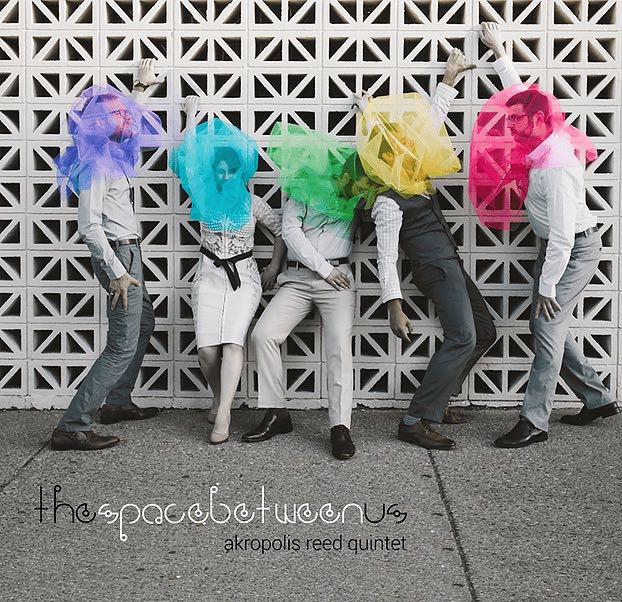
Prolific collaborators, Akropolis’ 2018 “Together We Sound” Detroit festival features an improvisatory new work with YAK and a concert with acclaimed soprano Shara Nova. Akropolis premiered the first work for reed quintet and string quartet by David Schiff with the Dover Quartet in 2015 and has performed with artists like the Miró Quartet and renowned clarinetist David Shifrin. In 2015 Akropolis gave an interactive, fully choreographed performance of Four-Letter-Word (Robbie McCarthy) with BodyVox Dance in Portland, OR, and has even performed with HarperCollins published author and scientist, Vic Strecher. In April 2017, Akropolis’ residency in Abu Dhabi featured a performance of Marc Mellits’ Splinter with original Arabic poetry performed by Khalifa University students, written around Mellits’ music.
Establishing Akropolis WORKS in 2016, Akropolis’ members teach an annual 7-week mini-course at the University of Michigan as well as a semester-long course at Michigan State University titled, “The Self-Managed Music Career,” and have delivered WORKS lectures to college-level musicians around the United States on marketing, financial planning, brand identity, and more. Equally committed to students K-12, Akropolis toured Illinois and Indiana on the Fischoff Educators Tour in 2015, collaborating with local school reading programs to musically re-enact a children’s book–“The Best Story”–by Eileen Spinelli. In 2013 Akropolis conducted its “Fall Education Tour”, funded by over $5,000 raised by a Kickstarter crowdfunding campaign. The tour visited 10 schools in Michigan serving underprivileged youth or under-funded arts programs. Continuing this effort, Akropolis will reach more than 6,000 K-12 students during its 17/18 season alone.
Akropolis has commissioned more than 30 works from composers in 7 countries and was selected to adjudicate and premiere the 2018 Barlow Prize funded by the Barlow Endowment, the first time the prize will be given for a reed quintet work. Akropolis produces a YouTube Web Premiere Series with more than 40,000 views, showcasing new works, arrangements, and composer interviews for a live Internet audience. In 2012 Akropolis created Akropolis Collection and has now sold over 140 original and arranged sheet music works to more than 30 new and established reed quintets.
Akropolis regularly appears in unconventional settings, including performances in office spaces in Detroit as part of its Corporate to Corner Tour in January, 2017. In May, 2016 Akropolis conducted a live recording session featuring audience participation for John Steinmetz’s Sorrow and Celebration for reed quintet and audience, which Akropolis commissioned in 2014. Akropolis will present its second annual Together We Sound festival in Detroit in May 2018, bringing together multidisciplinary collaborators, new works, and educational outreach to increase arts access throughout the city.
Akropolis is a 501(c)(3) nonprofit corporation and its 17/18 season is generously underwritten by Janet Krause and Ralph Crispino, Jr. All Akropolis events include informative musical introductions and a chance to greet the artists. Originating at the University of Michigan in Ann Arbor, Akropolis remains its founding members: Tim Gocklin (oboe), Kari Landry (clarinet), Matt Landry (saxophone), Andrew Koeppe (bass clarinet), and Ryan Reynolds (bassoon).


